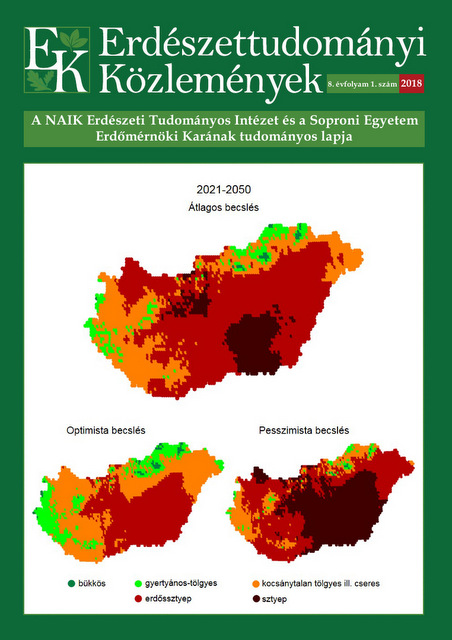| 1. | Baldocchi D.D., Black T.A., Curtis P.S., Falge E., Fuentes J.D., Granier A. et al. 2005: Predicting the onset of net carbon uptake by deciduous forests with soil temperature and climate data: a synthesis of FLUXNET data. International Journal of Biometeorology 49(6): 377–387. DOI: 10.1007/s00484-005-0256-4 |
| 2. | Bartholy J., Pongrácz R. & Gelybó Gy. 2007: Regional climate change expected in Hungary for 2071-2100. Applied Ecology and Environmental Research 5(1): 1–17. DOI: 10.15666/aeer/0501_001017 |
| 3. | Bonan G.B. 2008. Forests and climate change: forcings, feedbacks, and the climate benefits of forests. Science 320: 1444–1449. DOI: 10.1126/science.1155121 |
| 4. | Borovics A. 2018: A jövő már elkezdődött. Erdészeti Lapok 153(1): 2–5. |
| 5. | Führer E. 1994: Csapadékmérések bükkös-, kocsánytalantölgyes és lucfenyves ökoszisztémában. Erdészeti Kutatások 84: 11–35. |
| 6. | Führer E. 1995: Az időjárás változásának hatása az erdő fatermőképességére és egészségi állapotára. Erdészeti Lapok 130(6): 176–178. full text |
| 7. | Führer E. 2008: Erdőgazdaság. In: Harnos Zs., Gaál M. & Hufnagel L. (eds): Klímaváltozásról mindenkinek. Budapesti Corvinus Egyetem, Kertészettudományi Kar, Matematikai és Informatikai Tanszék, Budapest, 90–102. |
| 8. | Führer E. 2010: A fák növekedése és a klíma. „KLÍMA-21” Füzetek 61: 98–107. |
| 9. | Führer E. 2017: Az erdészeti klímaosztályok új lehatárolása öko-fiziológiai alapon. Erdészeti Lapok 152(6): 173–174. full text |
| 10. | Führer E. & Járó Z. 2000: Az aszály és a belvíz érvényesülése a Nagyalföld erdőművelésében. Erdészeti Tudományos Intézet Kiadványai 12. Erdészeti Tudományos Intézet, Budapest. |
| 11. | Führer E., Horváth L., Jagodics A, Machon A. & Szabados I. 2011: Application of a new aridity index in Hungarian forestry practice. Időjárás 115(3): 205–216. |
| 12. | Führer E., Jagodics A., Juhász I., Marosi Gy. & Horváth L. 2013: Ecological and economical impacts of climate change on Hungarian forestry practice. Időjárás 117(2): 159–174. |
| 13. | Führer E., Edelényi M., Horváth L., Jagodics A., Jereb L., Kern Z. et al. 2016: Effect of weather conditions on annual and intra-annual basal area increments of a beech stand in the Sopron Mountains in Hungary. Időjárás 120(2): 127–161. |
| 14. | Führer E., Gálos B., Rasztovits E., Jagodics A. & Mátyás Cs. 2017a: Erdészeti klímaosztályok területének várható változása. Erdészeti Lapok 152(6): 174–177. full text |
| 15. | Führer E., Horváth L., Móring A., Pödör Z. & Jagodics A. 2017b: Az erdészeti szárazsági mutató (FAI) segítségével lehatárolt erdészeti klímaosztályok/klímakategóriák jellemzése. Erdészeti Lapok 152(9): 270–272. full text |
| 16. | Gálos B., Führer E., Czimber K., Gulyás K., Bidló A., Hänsler A. et al. 2015: Climatic threats determining future adaptive forest management – a case study of Zala County. Időjárás 119(4): 425–441. |
| 17. | Gálos B. & Führer E. 2018: A klíma erdészeti célú előrevetítése. Erdészettudományi Közlemények 8(1): 43–55. DOI: 10.17164/EK.2018.003 |
| 18. | Halupa L.-né 1967: Adatok a sziki tölgyesek növekedési menetének vizsgálatából. Erdészeti Kutatások 63: 95–108. |
| 19. | Hoffmann G. & Lyr H. 1992: Phytohormone und synthetische Wachstumsregulatoren. In: Lyr H., Fiedler H.J. & Tranquillini W. (eds): Physiologie und Ökologie der Gehölze. Gustav Fischer Verlag Jena/Stuttgart, 345–369. |
| 20. | Járó Z. 1962: Termőhelyi tényezők ismertetése. In: Majer A. (ed): Erdő- és termőhelytipológiai útmutató. Országos Erdészeti Főigazgatóság. Budapest, 11–68. |
| 21. | Járó Z. 1972: A termőhely fogalma. In: Danszky I. (ed): Erdőművelés I. Mezőgazdasági Kiadó, Budapest, 47–87. |
| 22. | Járó Z. 1989: Az erdő vízforgalma. Az Erdő 38: 352–355. full text |
| 23. | Járó Z. & Tátraaljai E.-né 1985: A fák éves növekedése. Erdészeti Kutatások 76-77: 221–234. |
| 24. | Kaminszki A. 1924: Kelet-Európa klímatartományai, összehasonlítva az erdők elterjedésével. Petrograd (orosz nyelven). |
| 25. | Köppen W. 1931: Grundriss der Klimakunde. Walter de Guyter & Co, Berlin/Leipzig. |
| 26. | Körner Ch. 1999: Alpine plant life. Springer, Heidelberg. DOI: 10.1007/978-3-642-18970-8 |
| 27. | Lakatos M. & Bihari Z. 2011: A közelmúlt megfigyelt hőmérsékleti és csapadéktendenciái. In: Bartholy J., Bozó L. & Haszpra L. (eds): Klímaváltozás – 2011, Klímaszcenáriók a Kárpát-medence térségére. MTA-ELTE Meteorológia Tanszék, Budapest, 146–169. |
| 28. | Larcher W. 2001: Ökophysiologie der Pflanzen. 6. Auflage. UTB, Verlag Eugen Ulmer, Suttgart. |
| 29. | Linderholm H.W. 2006: Growing season changes in the last century. Agricultural and Forest Meteorology 137(1-2): 1–14. DOI: 10.1016/j.agrformet.2006.03.006 |
| 30. | Lyr H. & Hoffmann G. 1992: Wachstum – Einflussfaktoren. In: Lyr H., Fiedler H.J. & Tranquillini W. (eds): Physiologie und Ökologie der Gehölze. Gustav Fischer Verlag, Jena/Stuttgart, 397-437. |
| 31. | Magyar P. 1960: Alföldfásítás. I. kötet: Általános és leíró rész. Akadémiai Kiadó, Budapest. |
| 32. | Manninger M. 2004: Erdei fák éves és korszaki növekedésmenete és kapcsolódása egyes ökológiai tényezőkhöz. In: Mátyás Cs. & Vig P. (eds): Erdő és klíma IV. Nyugat-Magyarországi Egyetem, Sopron, 151–162. |
| 33. | Mátyás Cs. 2017: Az eDTR alapvető célkitűzései és működése. Erdészeti Lapok 152(10): 306–307. full text |
| 34. | Mátyás Cs., Berki I., Bidló A., Csóka Gy., Czimber K., Führer E. et al. 2018: Sustainability of forest cover under climate change on the temperate-continental xeric limits. Forests (megjelenés alatt) |
| 35. | Pisek A., Larcher W., Moser W. & Pack I. 1969: Kardinale Temperaturbereiche der Photosynthese und Grenztemperaturen des Lebens der Blätter verschiedener Spermatophyten. III. Temperaturabhangigkeit und optimaler Temperaturbereich der Netto-Photosynthese. Flora B 158: 608–630. DOI: 10.1016/S0367-1801(17)30246-6 |
| 36. | Stefanovits P. 1963: Magyarország talajai. Akadémiai Kiadó, Budapest. |
| 37. | Szőnyi L. 1962: Adatok néhány fafaj vastagsági növekedéséhez. Az Erdő 11: 289–300. full text |
| 38. | Tranquillini W. 1979: Physiological ecology of the alpine timberline. Ecological Studies 31. Springer, Heidelberg/New York. DOI: 10.1007/978-3-642-67107-4 |
